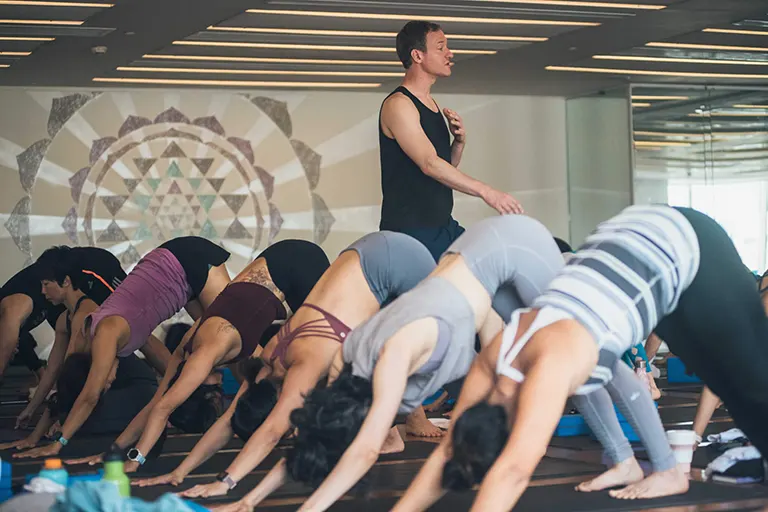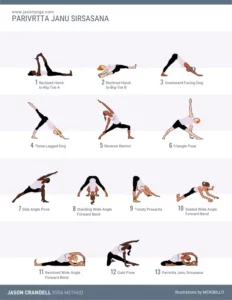If you’re not a yoga teacher, you probably don’t understand the utter ridiculousness of our daily commute or schedule inefficiencies. Yes, we’re happy that we rarely sit at a desk for 8+ hours a day. And, sure, having weird times like from 2:00pm to 3:45pm off most days is nice (sort of). But, the reality for most teachers is that we’re hustling from here to there to teach our classes, sub other teacher’s classes, and (often) making ends meet by working a second job. Jumping from studio-to-studio and class-to-class can fray our nerves. This makes it difficult to settle in and be present for our students.
Over the years, I’ve acknowledged that, for most full-time teachers, this is an inherent part of the job. For me, I’ve acknowledged that 30+ weekends of the year, I will do something very similar: I’ll wake up before 5am, fly for hours before arriving in another city (usually in a different time-zone), commute to the studio and go straight into teaching a weekend workshop. I’ve learned to manage these realities more skillfully so that I’m as relaxed and focused as I possible.
I know that if I’m relaxed, focused, and prepared I’ll be present and I’ll teach a class that makes me feel good. These days, I have conscious strategy to settle in before class starts—even if only for a moment or two. Here are my four tips to check your head and make sure you’re ready to teach class.
Take a Moment to Observe Your Body, Breath, and Mood
Let’s face it, we bring ourselves into the yoga room when we teach. Yes, it would be nice to say, “I check myself, my ego, and my issues at the door.” But, the truth is that we usually don’t. Not completely, at least. So, pause for a moment before you teach—before you reach the studio if possible—and become aware of what is happening inside of you. If you’re unaware of what’s happening inside of you it’s more likely that your unconscious patterns will influence your class.
For me, the most common scenario where this plays out is when I’m jetlagged and fatigued. Usually, when I’m in this state I feel flat and I overcompensate by talking too much and making things unnecessarily complicated. Since becoming aware of this pattern, I’ve gotten better at realizing that I’m in a state where I’m likely to overcompensate to everyone’s detriment. Now, I can usually stave this off by relaxing and simplifying.
Focus on What You’ve Been Practicing Lately
I’m going to tell you something that most teachers won’t: my personal yoga practice is only vaguely similar to the classes I teach these days. I practice diligently. I have for a very long time. And, for the first 10-15 years of teaching my personal practice and my classes were nearly identical. I needed the time my personal practice provided me to prepare for my classes. Now, however, when my personal practice is too similar to my classes, it feels like I’m at work. I love my work. I love my practice. I just don’t love when my practice feels like my work. I did in the past. Now, I don’t.
These days, I focus on subtle details in my personal practice more than ever. For example, I might spend a couple of weeks in my personal practice figuring out how to decompress the superior/anterior part of my hip socket in every posture. I’m going to translate all this work into my public classes, but I’m going to do it subtly. I’m going to distill the key things I figure out in my personal practice into viable, easy-to-access instructions. I’m going to make whatever I’m doing in my personal practice a thematic and sequencing focus in my public classes. But, I’m also going to make sure that my public classes have a really solid, compelling flow that covers additional territory my personal practice may not.
So, here’s the bottom line: Your practice doesn’t dictate what you’re teaching, but it will inform what you’re teaching. We’re teaching an embodied practice and you need to be doing practices that keep you attentive to your body. As you develop your plan for class, begin with what has been resonating in your practice lately.
Have a Plan—Even if it’s just a Feeling or an Idea
Some teachers operate best with a clear, detailed plan for class. Other teachers are better with improvisation. Both models can work&emdash;and, usually, most teachers combine the two. Whether you’re a planner or a gunslinger, it is essential that you treat the class like a learning experience for your students and have an idea what you’d like your students to take away from their experience. Sure, you can leave yourself open to changing your plan, but have a theme, pace, and intention in mind before class begins.
Even better, make your classes part of a broader syllabus that reflects the body of work that you’re trying to teach as an educator. Creating a syllabus takes effort and time. But, it also helps you clarify your teaching objectives and builds confidence. Ultimately, having a plan&emdash;even if it’s just an idea or feeling that you want to communicate to your students&emdash;will make the experience of teaching easier and more effective.
Be a Good Host
Imagine that teaching a class is like hosting an event at your home where each participant has to pay $15-20 to participate. If you were the host of such an occasion you’d default to basic social protocol and be nice to everyone and introduce yourself. Remember to follow these basic rules for making people feel welcome in your presence when you teach. While you’re at it, do your best to learn your student’s names. Believe it or not, most students don’t feel terribly comfortable coming to a class if they don’t already know you.
Students are often intimidated and somewhat intrigued by the teacher. Spend your energy putting them at ease. Not only is this the reasonable and humane thing to do, it will help you settle and focus on the students who are in your classroom.


